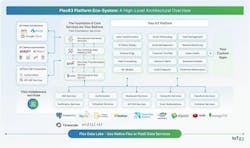From Two Years to Two Months: Re-engineering IIoT with Middleware
Industrial Internet of Things (IIoT) rollouts often bog down in bespoke protocol bridges, siloed data models and security hurdles that can drag deployments for as much as 18 months to two years. Leveraging a reusable, event-driven middleware layer can cut that timeline to roughly eight weeks, trimming the per-device cloud costs by an order of magnitude.
Companies that have tackled an IIoT project know that what begins as an exciting vision of connected machines and real-time data turns into a two-year grind, wrestling with security protocols, databases and dashboards. By the time data finally flows, needs have shifted, the budget is blown and the tech already feels dated.
In any software development program, new lines of code are the enemy; they mean cost, risk, time-to-market, maintenance and defects. Instead of writing hundreds of thousands of fresh lines and creating new enemies, industrial teams are now slashing deployment timelines from 18-24 months to as little as eight weeks.
The secret isn’t building harder; it’s building smarter. Forward-thinking engineers are dropping the “build-everything-from-scratch” mindset and adopting modular, cloud-flexible middleware that plugs straight into existing workflows.
READ MORE: A Human Side of Machines: One Woman’s Path Through Industrial Automation and Advocacy
Why Some IoT Approaches Have Failed
To understand why an eight-week deployment works, you need to know the 10-year history of industrial IoT failures. The market has undergone four distinct phases; each created its own deployment nightmare:
Phase 1: The big platform era (2014-2017). Companies like GE with Predix, Siemens and IBM Watson IoT promised complete systems. The reality? These solutions were huge, expensive and not very useful unless you bought their entire tech stack. For most equipment makers, this meant massive vendor lock-in with little flexibility.
Phase 2: The cloud trap (2017-2020). AWS IoT, Azure IoT and Google Cloud IoT created the "weekend demo" trap. Teams could build great demos quickly. But scaling to production hit huge complexity walls. One expert explains: "Over the weekend, you build a demo, you show the boss and they think we're in the IoT business. Well, no." The diagrams looked simple, but real implementation took months of custom work.
Phase 3: The No-code promise (2020-2022). Low-code and no-code platforms promised easier deployment at lower costs. However, they came with basic limitations that hindered strategic advantage. Companies found themselves stuck by platform limits just when they needed to innovate.
Phase 4: Today's reality (2022-present). Organizations are now stuck between expensive, risky custom builds that take 18+ months or cheap solutions that can't deliver a competitive advantage. This is the problem that modern middleware approaches finally solve.
Why Industrial IoT Projects Get Stuck
Walk into any organization that is trying its first IoT rollout, and you'll find digital engineering teams drowning in infrastructure work that has nothing to do with their real goals. The idea driving this pain? It looks easier than it actually is. Those clean AWS and Azure diagrams hide brutal implementation complexity. Teams spend months fighting with:
- Device security nightmares. How do you safely connect thousands of sensors without setting up each one by hand?
- Data routing chaos. Your vibration sensors speak Modbus, your temperature sensors use MQTT, and your old PLCs only understand OPC-UA
- Storage headaches. Where do you put all this data? How do you structure it when you're not sure what questions you'll ask next year?
- Dashboard development. Building custom visualization tools from scratch when you should be analyzing machine performance
The harsh truth is these software plumbing tasks eat 80% of schedules and budgets while adding zero competitive value. Teams end up writing 200,000 to 300,000 lines of new code for infrastructure that should already exist. You get a rigid, single-piece stack that feels outdated before your pilot program even ends.
Here's the real problem: The biggest competitor isn't another IoT platform, it's your own internal engineering team. Companies aren't choosing between different vendors; they're choosing between building everything internally vs. using proven solutions.
Modular Middleware Could Be a Solution
Instead of building everything from the ground up, an event-driven middleware layer between edge devices and business applications can be added. Think of it as the "universal translator" for industrial data, but one that's been battle-tested at massive scale.
The philosophy driving this approach: New lines of code are your enemy. Every line of custom code means cost, risk, time delays and an ongoing maintenance burden. Instead of writing hundreds of thousands of lines of new code, the middleware approach needs maybe 8,000 to 12,000 lines of changes to existing systems.
The magic happens because each service runs in its own container with a three-tier setup:
- A scalable foundation that just runs out of the box
- Middleware building blocks for specialized functions
- A custom application layer for business logic.
Deploy on AWS, Azure or Google Cloud, or keep everything on-site with full control. No code changes are required. This flexibility is crucial for plants with strict data control requirements.
Cutting Cloud Costs by 90%
Global OEM businesses can get locked into deals with cloud subscriptions that don’t allow OEM companies to own their solution IP. Hyperscalers can charge their clients $1 to $3 per connected device per month once the cloud computing solution is set up. This cost skyrockets as they scale up their solution with more features and number of connected devices in the long run.
However, traditional hyperscalers aren’t the only cloud solution that OEM companies can use to scale their connected device networks. A modular middleware platform is an alternative that has achieved notable results for OEMs from varying industries, including the energy domain. One such use-case example for scaling IoT solution with control on unit economies come from one of their recent project where:
- The total monthly cost per device per month while managing 2.5 million devices is ~$0.009.
- The total monthly cost per device per month while managing more than 18 million devices is ~$0.006.
This has allowed this equipment manufacturer to achieve economies of scale while they scale up their connected device network to help them cut their cloud computing costs by more than 90%. Beyond the cost savings, this platform allowed for faster implementation times and allowed the OEM to maintain complete control over their solution IP
What This Means for Daily Engineering Work
Speed improvements only matter if they make a job better. Faster 90%+ IIoT deployment translates to better engineering outcomes, including:
- Rapid field feedback loops
- Real vibration and thermal drift data now reaches CAD teams within hours instead of weeks
- Design verification cycles shrink from months to days (for example, imagine catching a resonance issue in your new pump housing before manufacturing 10,000 units and avoiding having to trash 10,000 units).
An early warning system that works means edge-side problem detection spots issues before they cascade. When bearing RMS vibration exceeds a preset threshold, equipment customers can get an alert while they can still schedule maintenance during planned downtime, instead of when the machinery is down and costing $50,000 per hour.
Additionally, automatic audit trails capture firmware versions, sensor calibrations and environmental conditions. Compliance reports write themselves, and certification cycles become predictable.
When the software infrastructure plumbing handles itself, engineers can focus on what matters: model-based optimization, digital twins, AI-powered predictive maintenance, unified connected platform ecosystem for legacy applications on any cloud service provider.
Security and Reliability
The biggest objection to faster deployment usually includes security and/or downtime concerns, and these are not merely theoretical concerns. They are mission-critical requirements, especially for infrastructure that could affect power delivery, manufacturing safety or public utilities.
The stakes are higher than most people realize. As one security expert explains: “If somebody can gain access to the cloud that controls power utilities, they could bring power delivery to its knees.” This level of consequence demands enterprise-grade security design, not startup-style "move fast and break things" approaches.
Here's how modern middleware architectures address these concerns:
Zero-trust device identity. Every device gets X.509 certificates that rotate automatically. Revocation lists are cached at the edge, so your security works even if the WAN connection drops. No device talks to anything without proving its identity first. This isn’t optional for mission-critical applications: It’s foundational.
Bulletproof service architecture. Each service is stateless and can restart independently. Need to patch the analytics engine? No problem. Do it without touching data ingestion or triggering plant downtime. Hot-swappable components aren’t just for hardware anymore. This architecture enables continuous improvement without operational risk.
Air-gap options for high-security sites. For facilities where security is paramount, data-diode gateways direct telemetry outward while blocking all inbound traffic. Your control networks stay completely isolated while still feeding data to optimization systems.
Battle-tested at scale. Leveraging pro-code middleware platforms brings you the proven infrastructure as code beneath simplifying deployments and handling millions of devices/data streams across telecommunications, utilities, oil & gas, semiconductors, and industrial machinery manufacturing. The security models have been stress-tested against both accidental failures and deliberate attacks.
READ MORE: Four Key Technologies Driving Data Analytics in Industrial IoT
Market Timing and Competitive Necessity
A move to IIoT middleware isn't accidental:
- Traditional single-piece solutions failed to deliver value at a reasonable cost
- Cloud platforms created complexity traps that most OEM teams can’t navigate
- No-code solutions lack the differentiation capabilities competitive markets demand
- AI demand has exploded, requiring platforms that were built with intelligence from the ground up
- Time-to-market pressures have intensified across all industrial sectors.
Compressing IIoT development timelines isn't about working harder. It's about reusing proven building blocks instead of reinventing the wheel. By adopting modular, cloud-agnostic middleware, design engineers get real data sooner, uncover failures earlier, and launch connected products while competitors are still fighting with message brokers.
The two-month timeline above transforms IIoT from a multi-year science project into a repeatable engineering solution pattern. In an industry where time-to-market increasingly determines success, that's not just a nice-to-have, but it's a competitive necessity.The infrastructure revolution has arrived in industrial settings. The question isn't whether you'll adopt these approaches, but whether you'll be early enough to gain competitive advantage from them. Businesses deploying use-case specific custom solutions today are positioning themselves for the next wave of technology adoption, while those still building infrastructure in-house, rely on low/no-code platforms, or lock-in with traditional hyperscalers risk being left behind by more agile competitors.
About the Author

Lee House
CEO, IoT83
Lee House, MSEE, MBA (Duke), brings three decades leading IoT, cloud and networking at GE, IBM and 3Com. As CEO of IoT83, he provides strategic guidance that helps OEMs outpace rivals through scalable, secure platforms. A sought-after thought leader, he translates emerging technology trends into competitive industrial advantage and growth. He can be reached at [email protected].


